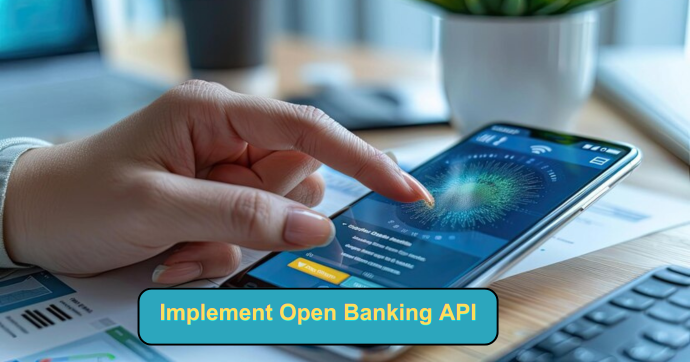December 1, 2024
Seamless Integration: How To Implement Open Banking API in Your Fintech App

Open banking is one of the most impactful innovations in recent years, which allows third-party apps to access and interact with financial data securely. For fintech companies, integrating open banking APIs can significantly enhance the functionality of their apps, offering users more convenience and control over their finances. But how can you seamlessly integrate open banking APIs into your FinTech app? In this blog, we’ll guide you through the process, focusing on the critical steps and considerations for smooth API integration.
What Is Open Banking?
Open banking is a system that allows banks to share financial information with third-party service providers through application programming interfaces. This enables these third-party providers to access a bank’s customer data, with the customer’s consent, of course. Open banking fosters innovation by allowing companies to offer more personalized and efficient services, transforming the financial industry.

Incorporating open banking APIs can improve the user experience for FinTech Software by offering services like personalized financial advice, faster payment methods, and easy access to various financial products. However, the integration process requires a clear strategy and understanding.
Why Open Banking APIs Are Important For Fintech Apps?
The implementation of open banking APIs in your fintech application allows you to provide a more robust and dynamic platform. Here are a few reasons why open banking APIs are essential:
- Increased Functionality: Open banking APIs give users access to a broader range of financial services without leaving the app. They can view multiple bank accounts, make payments, and manage their finances all in one place.
- Better User Experience: By streamlining access to banking services, open banking improves the overall customer journey, reducing friction and increasing convenience.
- Security and Compliance: Open banking APIs are designed with security in mind, adhering to industry standards such as PSD2 (Payment Services Directive). This ensures that data sharing is safe and complies with regulations.
Key Considerations Before Implementing Open Banking APIs
Before jumping into the integration process, it’s essential to evaluate your app’s current infrastructure and identify what changes may be necessary. Here are the main factors to take consider:
1. API Documentation and Compatibility
Review the documentation for the open banking API you plan to use. It should be detailed and straightforward to follow. Ensure that the API is compatible with your app’s framework and coding standards.
2. User Consent and Data Privacy
Open banking revolves around sharing sensitive financial data, so user consent is crucial. Your app must have robust mechanisms in place to ask for, store, and manage user consent. Transparency is key to building trust with your users.
3. Regulatory Compliance
Different regions have various regulations that govern data sharing and financial transactions. For instance, in Europe, the PSD2 regulation plays a critical role in open banking. Your app must comply with these legal standards to avoid any potential fines or restrictions.
4. Security Protocols
Security is always a top priority in fintech app development. Open banking APIs are built with security measures, but you must also ensure that your app is fortified. Use encryption, secure storage, and regular security audits to protect user data.
Steps to Seamlessly Integrate Open Banking APIs
Step 1: Choose the Right Open Banking API Provider
Not all open banking API providers are created equal. Choose a provider that aligns with your fintech app’s needs and long-term goals. Look for features like multi-bank support, easy integration, and top-tier security.
Step 2: Design a User-Centric Interface
The success of your open banking integration heavily depends on how user-friendly the experience is. Design your app’s interface to make it simple for users to connect their bank accounts, manage permissions, and perform financial transactions without hassle.
Step 3: Ensure Strong API Security
Even though open banking APIs come with built-in security protocols, it’s essential to strengthen your app’s security with additional measures. Implement two-factor authentication (2FA), data encryption, and regular vulnerability assessments to keep your app and users safe.
Step 4: Test for Performance and Scalability
Before launching the integration, conduct extensive testing to ensure the API works flawlessly within your app. Now is the perfect time to build mobile fintech apps that embrace this technology, providing users with the financial flexibility and control they expect. Performance testing is critical to ensuring the API can handle large volumes of data without slowing down or crashing. Make sure your app can scale efficiently as user demand grows.
Are you looking to hire a developer to build your high-end project? Hire our experienced developers today!
Common Challenges During API Integration
Integrating open banking APIs is not without its challenges. Here are some potential challenges you could encounter:
- Compatibility Issues: If your app is built on an older framework, you may run into compatibility issues with modern open banking APIs.
- Data Privacy Concerns: Users may be reluctant to share their financial data. It’s crucial to communicate how their data will be used and ensure strong privacy protection features.
- Regulatory Changes: Regulations surrounding open banking are evolving. Staying compliant can be a moving target, requiring continuous monitoring and adjustments to your app’s data-handling processes.
Best Practices for Open Banking API Integration
If you’re ready to take your app to the next level, now is the time to hire app developer experts in fintech who understand the intricacies of open banking API integration and can help you stay ahead in this competitive market.
1. Keep Users Informed
Always keep your users in the loop about what data is being shared, with whom, and why. Provide them with an easy-to-understand consent process and clear terms of service.
2. Focus on Security
Security should be your top priority. Along with the built-in protections from the API, invest in additional security measures such as firewalls, encryption, and continuous monitoring to detect any threats.
3. Regular Updates and Maintenance
After launching the API integration, the work isn’t over. Ensure that your app’s API connection is always up to date with the latest security patches and performance enhancements.
Conclusion
Integrating open banking APIs into your app offers many advantages, from improved user experiences to enhanced functionality. By taking the time to choose the right API provider, focusing on security, and ensuring a seamless user interface, you can successfully build a more robust and dynamic platform. Open banking is not just a trend; it’s the future of financial services.
Read More-: 10 Places To Get Deals On Hire Dedicated App Developers India
Tags-:





